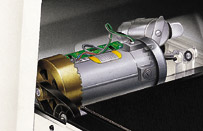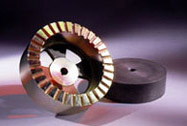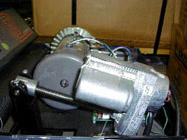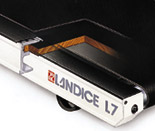|
WE BUILD THE STRONGEST FRAME.
|
|
The Landice frame is made of aircraft quality 6063-T6 aluminum and secured with aircraft locking hardware. Costing three times more than steel, aluminum gives our frame the strength to support a user weighing up to 500 lbs.
|
 |
- Aluminum is an inert material — It does not rust.
When you run on a treadmill, you sweat. Sweat is salt water, which is highly corrosive and causes steel to rust. Steel treadmill frames, like automobiles, are painted to delay the rusting process but eventually, like automobiles, steel frames can rust from the inside out over the life of the treadmill.
- Aluminum is three times stronger than steel per unit weight
The Landice treadmills use aluminum frame construction and weigh over 275 lbs. It is this strength that allows us to offer up to a 500-lb. user weight capacity and a lifetime frame warranty. When money is not an option, auto manufacturers turn to aluminum over steel for car frames and engine blocks, therefore maximizing power and strength while simultaneously reducing weight.
- Aircraft locking hardware is more reliable than welding
Both aircraft and Landice treadmills are assembled with locking hardware. Locking hardware provides a reliably repeatable system of securing the frame. The problem with a weld is that without x-ray equipment it is impossible to tell if a weld is solid. Poor welds may look solid but can lead to squeaking and eventually structural failure. Just as airplane wings do not fall off airplanes, Landice frames retain their structural integrity after years of heavy health club usage.
When human lives are at stake in applications such as bridges and airplanes, designers choose to bolt rather than weld for consistent reliability.
| BRAND |
FRAME |
WEIGHT |
| Landice |
Aluminum |
270 lbs. |
| Cybex |
Steel |
240 lbs. |
| True 500 |
Steel |
240 lbs. |
| Precor 9.2s |
Aluminum |
192 lbs. |
| Pacemaster Pro+ |
Aluminum |
175 lbs. |
| Life Fitness 3500 |
Steel |
160 lbs. |
|
|
WE USE THE MOST POWERFUL DRIVE MOTOR.
|
|
Landice uses a 3 HP continuous duty drive motor. Made in the USA, this motor can continuously deliver 3 HP in our treadmill without overheating.
|
 |
- Importance of horsepower rating
A 1.5 HP motor will run twice as hot as a 3 HP motor delivering the same load. The hotter a motor runs, the faster it will burn out. A good analogy involves a pickup truck and a dump truck. You can load both with the same number of bricks and drive them across the country back and forth for a year. The dump truck, however, will obviously last much longer.
- Importance of the continuous duty rating
Beware of motors that depart from the continuous duty rating. The Landice motor is rated for 4.5 peak horsepower, which means it can deliver 4.5 HP for 15 minutes before it begins to overheat. If you overheat your motor you will shorten its life span.
- Look at the drive motor's physical size and construction quality
Be sure to look at a motor’s physical size before buying a treadmill. Compare its size to that of a Landice for a good indication of its true continuous duty rating. Be sure to check out the quality of the motor. Does the motor have an integrated fan for additional cooling in its design or was it an after thought. What materials were used in the construction of the motor...metal, plastic or even paper?
|
|
WE USE THE HEAVIEST INSTITUTIONAL GRADE STEEL ROLLERS
|
Look at our competitors who sell both home and club treadmills. All offer larger diameter rollers in
their more expensive institutional treadmills.
When it comes to their home models, they often sacrifice the quality of their treadmill by using less expensive, smaller diameter rollers.
|
 |
- Larger rollers provide for less friction and longer life
The larger the roller diameter, the less tension required on the treadbelt since the roller has more surface area to grab the belt. Decreased tension means decreased friction and longer life on belts and bearings.
- Larger rollers allow us to use a large industrial bearing
Landice treadmills use a 2.05” industrial bearing. Even some of our competitors’ larger institutional rollers use a less durable 1” bearing with a spacer to fill the rest of the tube. Landice roller bearings are completely sealed using polyurethane gaskets
- Landice uses the thickest steel tubing in the industry
Compare the 5/16” wall thickness of our rollers to our competitors’. You notice that ours are considerably thicker. The strength of these walls prevents the bearings from “cocking.” Knocking, noisy bearings are often caused by a “cocked” bearing. To further prevent “cocking,” Landice mills a seat in the roller for the bearing to sit on. Many competitors simply rely on the friction of the tube to hold the bearing in place.
- Landice rollers weigh 14 pounds (L7 Series) and 22 pounds (L8 Series)
If you pick up a Landice roller, you will notice it weighs significantly more than our competitors’. In fact, it weighs more than many of our competitors’ flywheels. Our rollers actually act as two extra flywheels in the treadmill, further contributing to smooth operation and longer treadmill life.
- Landice rollers are crowned
Larger diameter rollers naturally track better than smaller ones. Landice further enhances belt tracking by machining a crown on its front and rear rollers.
|
|
WE BUILD A BETTER FLYWHEEL
|
|
Sparing no expense, Landice uses a state-of-the-art custom flywheel in our treadmill, providing us with the highest inertia in the industry.
|
 |
- Inertia: The measure of a well-designed flywheel
Put simply, inertia is the measure of how effectively a flywheel keeps the treadmill from slowing down when a runner’s foot strikes the treadbelt. A properly-designed flywheel will not only provide for a smooth, consistent feel but will also protect the motor and electronics from the stress and pounding associated with treadmill use.
- Maximize inertia: Put the weight in the outside of the flywheel
Landice uses an expensive casting process to construct our flywheel. We pour liquid steel in a hollow mold, which allows the flywheel to have 3/4 of its 14 pounds in its outside edge. Many of our competitors use a less expensive method of cutting the flywheel out of tube of solid steel. Our cast flywheel acts with the inertia of a 42-pound solid flywheel but with the benefit of placing only 14 pounds of pressure on the motor shaft and bearings of the motor.
- Maximize inertia: Spin the flywheel faster
Landice spins our motor at 3200 rpm, 1/3 faster than the industry standard 2400 rpm. This increases the inertia effect of the flywheel 1.77 times, allowing the motor and electronics to run smoother and cooler, which helps them last longer.
- Beware of heavy flywheels
A heavy solid mass flywheel is one way of achieving high inertia. One of our competitors once tried a 30 lb. solid mass flywheel. The result was a disaster due to excessive over– loading of the motor bearings.
|
|
WE USE THE MOST POWERFUL ELEVATION MOTOR
|
Put three heavy people on a Landice treadmill and try the electric elevation. You will notice that the treadmill is as quiet as it would be with no one on the treadmill.
Perform the same test with our competitors’ models and you will definitely hear the strain in their elevation motors. Some even stop elevating.
|
 |
- Our elevation motor delivers 1000 pounds of thrust
Landice’s treadmill elevation motor delivers 1000 pounds of thrust across the entire range of the treadmill’s 15 % elevation. The 1000-pound rating allows up to a 500-pound user to run on the treadmill at top speed and still elevate smoothly during all phases of operation.
- But I don't weigh 500 pounds
Consider the dump truck and the pickup truck. You can load both with the same number of bricks and drive them around town for the day. The dump truck will obviously last much longer. The same is true for elevation motors. The higher the thrust rating, the longer it will last, no matter what the load.
|
|
WE USE THE FINEST, MOST EXPENSIVE TREADBELT
|
 |
- Landice 4-ply treadbelts are twice as strong as our competitors’
Lift up the edge of a Landice treadbelt and count the number of layers. You will easily see the 4 layers which make up the treadbelt. Compare us to our competitors. You will notice that most use a 2-ply treadbelt. Although costing significantly more, this 4-ply belt provides twice the strength of a 2-ply belt.
- Why do I need a strong treadbelt?
As a treadbelt stretches, it begins to slip. In order to compensate for this slippage, every treadmill has two take-up or tensioning screws on the rear roller, which are used to re-tighten the treadbelt. The problem with weaker 2-ply belts is that eventually (usually outside the warranty period) the belt has stretched to the point where the rear roller hits the back of the treadmill and can no longer be tightened. The over-stretched treadbelt must then be replaced. Even under the heaviest institutional usage, Landice 4-ply belts do not over-stretch.
- Landice treadbelts keep friction under control
Friction between the deck and belt is the number one enemy of a treadmill. Increased friction causes the motor to draw high amperage and generate excessive heat, which in turn reduces motor and
electronic life. A myriad of costs and options are available to treadmill manufactures when it comes to selecting the material for the underside of their treadbelt. A cheap belt material may be suitable for the conveyor at the checkout counter at your local supermarket, but in a treadmill it can fail within hours.
|
|
WE USE THE STRONGEST DECK WITH THE LONGEST LIFE
|
 |
- Landice's 1” thick decks are the strongest in the industry
The running deck receives impact force more than double a runner’s weight. Our 1” thick deck is 237% stronger than our nearest competitor’s 3/4” system.
- Our no-maintenance decks have a life of over 3000 hours perside
Most treadmill manufacturers use a one-sided deck with a single phenolic coating. Landice’s five process deck system is applied to both sides of our deck. Consisting of 2 phenolic layers, wax impregnation, TFE, and SlipCoating, this process provides for a life of over 3000 hours per side. This equates to a life of over 20 years in a residential setting. In heavy institutional settings where usage can be as high as 5 hours per day, Landice SlipCoat can be applied on a monthly basis to further extend belt and deck life.
- We do not switch belt/deck systems until we know they work
Many of our competitors change their belt/deck systems from year to year. This is a sure sign that they are still searching for a reliable combination. Since 1967 Landice has continuously run treadbelts and decks on our life testers searching for longer life. We do not even begin to consider a new material until it has lasted at least 3000 hours, the equivalent of 10 years of home treadmill use.
|
|
OUR EXCLUSIVE SOFTER-THAN-GRASS VFX FLOATING DECK SYSTEM
|
 |
The VFX (Variable Flex) system features multiple shock-absorbing elements, which self-tune to a user’s stride to provide optimal performance in the strike, thrust, and kick zones.
Absorbing shock in the vertical direction only, the VFX system is softest when the runner’s foot strikes the deck. During this strike, the system does not allow side-to-side or rocking motions, which can be harmful to joints and knees.
Because the floating deck system can not move backwards, the system provides firm thrust and a stiffer kick zone creating a realistic “outdoor” feel regardless of where you run on the deck (front, middle, or rear).
CONSTRUCTION DETAILS
The unique design of the VFX system uses multiple posts, which guide the floating deck in the vertical plane. Tight tolerances between the floating deck and guiding posts eliminate non-vertical movements common with other moving deck shock absorption systems.
Unlike springboard suspension systems which require the user to be positioned at the front edge of the deck to get maximum shock absorption, the VFX design allows a user to run anywhere on the treadmill while still providing the maximum shock absorption obtainable. Our 1-inch thick “floating” deck maintains up to a 500-pound weight capacity and structural integrity not found in 3/4-inch thick or less “flexing” deck systems.
|
|











